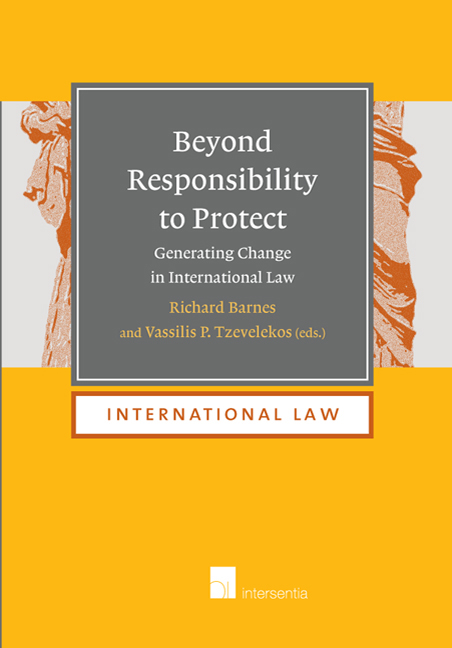Book contents
- Frontmatter
- Dedication
- Foreword
- Acknowledgements
- Contents
- Table of Cases
- List of Authors
- Introduction
- Part I The Moral Underpinnings and Political Ends of R2p
- Part II International Institutions And Their Role In R2p
- PART III De Facto Regimes and Non-State Actors Within a State And as a State
- Part IV R2p and Due Dilligence Regarding the Conduct of Corporations
- Part V The Interaction Between R2p And Humanitarian Law Obligations To Protect Civilian Populations
- PART VI R2p and International Criminal Law Beyond the Four R2p Crimes
- Part VII R2p and its Possible Impact on the Law of International Responsibility
- The ICJ Judgment in the Genocide Convention Case: Is R2P Drawing New Horizons for the Law on State Responsibility?
- Responsibility to Protect as a Basis for ‘Judicial Humanitarian Intervention’
- Military Commanders as Bystanders to International Crimes: A Responsibility to Protect?
- Commentary: R2P as a Transforming and Transformative Concept in the Context of Responsibility as Liability
- Part VIII Concluding Observations
- Index
Military Commanders as Bystanders to International Crimes: A Responsibility to Protect?
from Part VII - R2p and its Possible Impact on the Law of International Responsibility
Published online by Cambridge University Press: 19 September 2018
- Frontmatter
- Dedication
- Foreword
- Acknowledgements
- Contents
- Table of Cases
- List of Authors
- Introduction
- Part I The Moral Underpinnings and Political Ends of R2p
- Part II International Institutions And Their Role In R2p
- PART III De Facto Regimes and Non-State Actors Within a State And as a State
- Part IV R2p and Due Dilligence Regarding the Conduct of Corporations
- Part V The Interaction Between R2p And Humanitarian Law Obligations To Protect Civilian Populations
- PART VI R2p and International Criminal Law Beyond the Four R2p Crimes
- Part VII R2p and its Possible Impact on the Law of International Responsibility
- The ICJ Judgment in the Genocide Convention Case: Is R2P Drawing New Horizons for the Law on State Responsibility?
- Responsibility to Protect as a Basis for ‘Judicial Humanitarian Intervention’
- Military Commanders as Bystanders to International Crimes: A Responsibility to Protect?
- Commentary: R2P as a Transforming and Transformative Concept in the Context of Responsibility as Liability
- Part VIII Concluding Observations
- Index
Summary
INTRODUCTION
After the international community was confronted by its failure to prevent the genocides in Rwanda and Bosnia-Herzegovina in the 1990s, the victims’ relatives started a lengthy quest for legal accountability for this failure. Although the complaints were initially addressed to the United Nations (UN), later on the question was raised as to whether the troop contributing states (TCC s), and the individual commanders involved were to blame as well. It was the Dutch Court of Appeals’ conclusion that the Dutch battalion in Srebrenica was specifically instructed to ‘take all reasonable measures to protect refugees and civilians in [their] care’ that raised the question whether the military commanders of the Dutch battalion could bear responsibility for the death of three men in the Bosnian enclave of Srebrenica in 1995. An intermediate judgment handed down in 2010 by the Brussels District Court had already indicated that the Belgian state and the commanders of the Belgian battalion in Rwanda could share the responsibility for the genocide in the Rwandan city of Kigali in 1994.
These developments indicate that the criminalisation of inaction on the part of military commanders may become a recurring modality when peacekeeping missions prove unsuccessful. As a result, domestic judiciaries will be confronted directly with a thorny question of international law. The consideration of international legal provisions in this regard is inevitable. Aft er all, complex peacekeeping missions take place in a grey area between war and peace and are as such not only dealt with by domestic law, but also by international law. The 1999 humanitarian intervention in the former Yugoslav province of Kosovo was the main incentive for the establishment of the Responsibility to Protect (R2P) doctrine. Although the legality of the air strikes carried out by the North Atlantic Treaty Organisation (NAT O) was debatable, its success was proven beyond reasonable doubt. As a result, one could argue that the successful prevention of further human suffering through enforcement measures taken by the international community as a whole has demonstrated that international law should adopt a norm that prevents international crimes rather than punish them post facto.
- Type
- Chapter
- Information
- Beyond Responsibility to ProtectGenerating Change in International Law, pp. 393 - 414Publisher: IntersentiaPrint publication year: 2016

